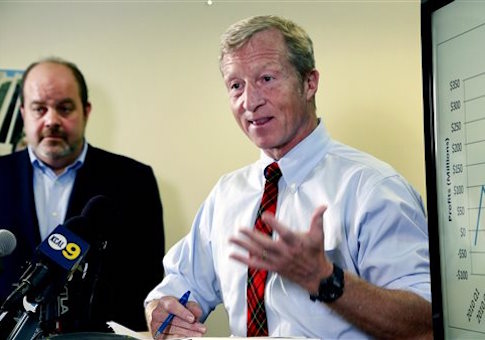The business arm of billionaire Democrat Tom Steyer’s political advocacy network worked behind the scenes with senior administration officials to undermine a study by a federally commissioned group that criticized environmental regulations, internal emails show.
Advanced Energy Economy (AEE), a Steyer-funded trade association, briefed senior administration officials on ways to preemptively debunk an anticipated study questioning EPA regulations’ impacts on the U.S. power grid.
Leading AEE’s effort was an executive who just months earlier had left a prominent position at the EPA. However, the agency says that he did not meet the statutory definition of a "senior official" and hence was not subject to lobbying restrictions placed on recently departed federal employees.
AEE is one of three politically oriented groups run out of and coordinated by Steyer’s office. While his political and policy efforts garner more press attention, emails obtained by the Energy and Environment (E&E) Legal Institute through Freedom of Information Act requests reveal ways in which his coalition of green energy businesses also affects public policy.
Arvin Ganesan, AEE’s vice president for federal policy, emailed a handful of EPA and White House staffers in January 2015. "Several of us talked last month about rebutting" a November study from the North American Electric Reliability Corporation (NERC), a nonprofit tasked by the federal government with monitoring and developing standards for electricity reliability.
Critics of the EPA’s power plant regulations were already citing NERC’s study, which questioned the impact of EPA power plant regulations on electrical grid reliability and suggested they delay the rule’s implementation.
"NERC’s report underscores the growing reliability concerns with EPA’s unworkable plan," Rep. Ed Whitfield (R., Ky.), chairman of the House Energy and Commerce Committee’s panel on energy and power, said of the report’s release.
Ganesan wanted to huddle with administration officials about an AEE-commissioned study to push back on the findings of the federally chartered nonprofit group. After the release of the study, he wrote, AEE would enlist member companies to pressure the Federal Energy Regulatory Commission (FERC), which oversees NERC, to discount its findings.
AEE, a trade association with more than 80 members, "will have [its rebuttal] amplified by our companies at the various FERC technical conferences," Ganesan wrote.
After some back-and-forth, the EPA penciled him in for a Feb. 19 meeting with Joe Goffman, one of the lead architects of the agency’s power plant rule, and Janet McCabe, the acting chief of the EPA’s air quality division.
"All sounds very promising. We look forward to seeing the results," Goffman wrote.
Just months before, Ganesan had been Goffman’s and McCabe’s colleague. He was the EPA deputy chief of staff for policy until October 2014, when he left to join AEE. "He will be a tremendous asset as we work with Congress and the Administration to create a prosperous future powered by secure, clean, affordable energy," the group’s CEO said of the hire.
E&E attorney Chris Horner said the emails showed a violation of the spirit if not the letter of the Obama administration’s efforts to crack down on the revolving door between federal agencies and external groups that lobby them.
"These latest emails help illustrate—whatever executive orders and lobbying restrictions might say about ‘revolving doors’ and the like—the close and indeed enabling relationship between rent-seeking industry and the administration that seeks to ‘bankrupt’ those industries' competitors," Horner said, referring to the green energy and coal industries, respectively.
An EPA spokesman said that Ganesan was not a "senior official" as defined by federal law, and therefore was not subject to the "cooldown period" that prohibits some former federal officials from lobbying their old employers.
Neither AEE nor Ganesan responded to a request for comment.
Horner sees his collaboration with EPA as an extension of Steyer’s larger political and policy efforts. "Coming from AEE, this thread must be read as of a part with emails from Team Steyer boasting how groups they ‘founded and fund’ are ‘coordinated’ … to achieve that very same goal," he said in an email.
Horner was referring to emails obtained through previous FOIA requests that detailed the role of AEE in Steyer’s larger political project. They include communications from Ted White, the managing partner of Fahr LLC, Steyer’s home office.
Fahr is "an umbrella entity for prominent investor and philanthropist Tom Steyer's extensive business, policy, political, and philanthropic efforts," according to White’s law firm.
"There are three areas of focus for us, housed in three independent but coordinated entities: business (accelerating the transition to an advanced energy future): policy (related to climate and energy); and political (acting politically to prevent climate disaster and to enable advanced energy businesses to succeed)," White wrote in a 2013 email.
To advance those goals, White wrote, "we founded and fund" three distinct but coordinated organizations: AEE; the Center for the Next Generation, Steyer’s policy nonprofit; and NextGen Climate Action, his deep pocketed Super PAC.
NextGen was the wealthiest Super PAC of the 2014 election cycle. Next Generation serves as a high-profile sister organization. AEE, though less conspicuous, is also wielding influence.
